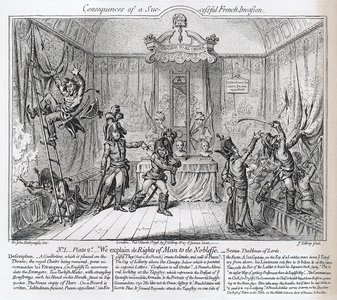Consequences of a Successful French Invasion, No 1. Plate 1st "We come to recover your long lost Liberties." Scene The House of Commons
Only £225.00
Size 39cm x 35cm
Originally published by Hannah Humphrey etched by James Gillray from 'The Genuine Works of James Gillray, engraved by himself. Thomas McLean edition on heavy rag-paper from the original copper plates printed 1830.
This is the first plate of what was intended to be a 20 plate series, described in a Pamphlet by Sir John Dalrymple and drawn and etched by Gillray, warning about the consequences of a French invasion. The scene for each plate was to be set in a different locale presumably to suggest how every facet of British life, political, economic, judicial, social, religious, and military—would be transformed by the invasion. Only four of the plates, however, were actually completed. For more information about the genesis, background, and other plates in the series, see my Introduction to the Consequences of a Successful French Invasion.
This plate, set in the House of Commons, purports to show the consequences of a French invasion upon the lower branch of Parliament. The subtitle of the print, "We come to recover your long lost Liberties." is bitterly ironic for what we see is the wholesale destruction of the people and institutions that according to Dalrymple and Gillray have been supporting British freedom.
A revolutionary bonnet rouge with the inscription "Egalité" has been placed over part of the royal crest atop the Speaker's chair. The lion and unicorn start back from it in alarm. The Speaker of the House (Henry Addington), no longer allowed to speak, is shown (appropriately) gagged while two French soldiers apply manacles and fetters to his hands and feet. Pitt, Dundas, and two court scribes (with pens on their ears), are bound back to back: the scribes with cords, but the potentially more dangerous Pitt and Dundas with iron chains and huge padlocks. The entire ministry side of the House has had their heads shaved and appear chained together, dressed as convicts on their way to a penal colony. Indeed, the back of the Speaker's chair makes it clear where these members of Parliament are headed: "This House adjourned to Botany Bay [the English penal colony in Australia] sine die" (i.e. with no date for resumption).
Not surprisingly, in the foreground, a table with the foundational documents of the British parliamentary system has been overturned. The documents strewn over the floor include "Magna Charta," the "Declaration of Rights," the "Hanoverian Succession," and the "Journals of the House" with pages torn. All of these are about to be added to the flaming chafer to which an English cobbler wearing a bonnet rouge, is applying the bellows—the better to consume a set of Parliamentary "Records" and "Journals." Nearby, another British convert to Jacobinism, a blacksmith, is destroying one of the oldest symbols of royal authority, the Parliamentary mace.
Most of the details of the design are taken directly from Dalrymple's description, which appears below the print. But Gillray does make a couple of significant changes of his own. In Dalrymple's design, both sides of the house were to be "dressed in the Uniform of the Convicts of Botany Bay." But in Gillray's representation the soldiers of the Revolution, led by a soldier who looks suspiciously like Gillray's early renditions of Napoleon, all come from the Opposition (Whig) side of the House. And contrary to Dalrymple's express charge to Gillray "not to introduce a single Caricature, or indulge a single Sally that could give pain to a British subject" we can see shades of Gillray's favourite Opposition targets, Sheridan and Fox, in the Jacobin cobbler and blacksmith (also on the Opposition side). But their features are toned down and disguised just enough to allow Gillray plausible deniability of having disregarded his client's direction. (www.james-gillray.org)
 View Account
View Account
